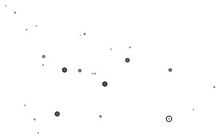Psi Cassiopeiae
| Observation data Epoch J2000.0 Equinox J2000.0 | |
|---|---|
| Constellation | Cassiopeia |
| Right ascension | 01h 25m 56.022s[1] |
| Declination | +68° 07′ 48.05″[1] |
| Apparent magnitude (V) | +4.72 |
| Characteristics | |
| Spectral type | K0III |
| U−B color index | +0.94 |
| B−V color index | +1.05 |
| Variable type | none |
| Astrometry | |
| Radial velocity (Rv) | −12 km/s |
| Proper motion (μ) | RA: 75.50 ± 0.18[1] mas/yr Dec.: 26.93 ± 0.16[1] mas/yr |
| Parallax (π) | 16.72 ± 0.18[1] mas |
| Distance | 195 ± 2 ly (59.8 ± 0.6 pc) |
| Absolute magnitude (MV) | +0.86 |
| Other designations | |

Map of the Bayer-designated stars in Cassiopeia. Psi Cassiopeiae is circled.
Psi Cassiopeiae (ψ Cas, ψ Cassiopeiae) is a binary star in the constellation Cassiopeia. It is approximately 195 light years from Earth.[1]
The primary component, ψ Cassiopeiae A, is an orange K-type giant with an apparent magnitude of +5.0;[2][3] it is a double star, designated CCDM J01259+6808AB,[4] with a fourteenth magnitude star (component B) located 3 arcseconds from the primary. Located about 25 arcseconds distant there is a 9.8 magnitude optical companion CCDM J01259+6808CD, designated ψ Cassiopeiae B in older star catalogues,[2] which is itself another double;[2][5] CD comprises a 9.4 magnitude component C and a 10 magnitude component D.[6]
Notes
- ↑ 1.0 1.1 1.2 1.3 1.4 1.5 van Leeuwen, F. (2007). "Validation of the new Hipparcos reduction". Astronomy and Astrophysics 474 (2): 653–664. arXiv:0708.1752. Bibcode:2007A&A...474..653V. doi:10.1051/0004-6361:20078357.Vizier catalog entry
- ↑ 2.0 2.1 2.2 Norton, Arthur P. (1973), Norton's Star Atlas, p. 118, ISBN 0-85248-900-5
- ↑ Vizier, retrieved 2009-04-13
- ↑ SIMBAD, retrieved 2009-04-13
- ↑ SIMBAD, retrieved 2009-04-13,
CCDM J01259+6808CD -- Double or multiple star
- ↑ VizieR Detailed Page, retrieved 2009-04-13
| ||||||||||||||||||||||||||||||||||||||||||||||||||||||||||||||||||||||||||